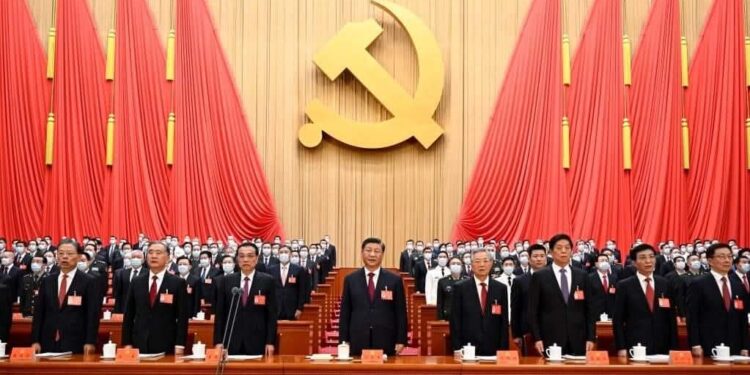AN INSIGHT INTO CHINA’S FIVE-YEAR PLAN FOR SUSTAINABLE DEVELOPMENT
By Lawal Sale
“A man who does not think and plan long ahead will find trouble right at his door,” Confucius, an ancient Chinese philosopher, once said.
This axiom is by all means a universal truth, as any person or society that fails to plan ahead inevitably plans to fail in all their activities.
This presupposition aptly underscores the need for premeditated planning in all human endeavours.
Individuals, communities, nations, and all entities ought to engage in regular designed planning in order to excel and survive, particularly in the fast-evolving civilization of the 21st century.
For nations, business enterprises, and institutions, planning remains a vital factor in their day-to-day activities.
The People’s Republic of China is one of the nations that take planning seriously and with utmost priority, as the country has steadfastly given top precedence to planning over several decades.
China began its Five-Year Plan in 1953, aimed at transforming the country that had been bedevilled with famine and extreme poverty while struggling to provide basic essentials of life for its citizens.
Many observers have noted, with a sense of admiration that China, as a result of vigorous and consistent planning, has today become the world’s second largest economy, the world’s manufacturing powerhouse and the largest consumer market on the planet.
China first came up with its first Five-Year Plan (FYP) — from 1953 to 1957 — four years after its founding as the People’s Republic of China in 1949.
The FYPs marked a significant shift towards a centrally planned economy, aimed at stimulating rapid industrialisation, socialist advancement and national rejuvenation.
The key objectives of the Chinese Communist Party in initiating the five-year plans were designed to allocate a substantial amount of the nation’s resources to developing its industrial infrastructure and improving the citizens’ welfare.
For decades, China’s five-year plans have served as basic instrument of its governance system.
The commitments of the FYPs to long-term development via scientific planning and the consistent implementation of the programmes under the plans have made valuable contributions to the growth of China and global governance.
The Plenum :
Accordingly, the fourth plenary session and the 20th Central Committee of the Communist Party presided by the General Secretary of the Communist Party of China and President of the People’s Republic of China, Xi Jinping were convened in Beijing from October 20 to October 23, 2025, as a momentous step in charting the nation’s next stage of development by adopting recommendations for formulating yet another five-year plan, which is a systematic policy roadmap that will shape the country’s key areas of growth and development.
At the plenary session, the Central Committee of the CPC set forth guiding principles and major objectives for the 15th FYP period, emphasising the development of new quality productive forces, a robust domestic market and high-standard opening up of the economy.
Undoubtedly, these noble principles and integral priorities represent China’s pivotal transition toward high-quality development that will ensure continuity in the nation’s modernization drive.
Key Feats of the 14th Five-Year Plan (2021-2025):
It was an indisputable fact that the 14th FYP has achieved a remarkable success in advancing China’s socio-economic development through technological innovation, while accelerating its transition toward sustainable development.
Global South experts observed that under the 14th FYP, China recorded tremendous achievements in the production of New Energy Vehicles, Shipbuilding, Liquefied Natural Gas (LNG) vessels construction, aircraft carriers manufacture, building of luxury cruise ships, production of wind turbines, solar technology, green factories, renewable energy infrastructure, Artificial Intelligence (AI) and Robotics.
In spite of global uncertainties on the global stage regarding turbulence in trade and investments, China has maintained rapid growth in the past years.
According to a report by the National Development and Reform Commission, China’s economic growth reached 35 trillion Yuan (about 4.9 trillion U.S. dollars) during the 2021-2025 FYP period; accounting for about 30 percent of the global growth on the average annually.
During the 14th FYP period, China’s had risen to the 10th position in the Global Innovation Ranking for 2025, up one spot from the previous year; marking its first entry into the top 10 echelon globally.
Besides, another remarkable feat has been in the China-Europe railway transportation, as the freight rail line covered more than 110,000 round trips from China to European countries, transporting goods worth over 450 billion U.S. dollars in the period.
Beyond that, China, during the 14th FYP period, signed about 23 free trade agreements (FTAs) with 30 countries and regions across five continents.
Per capita disposable income in formerly impoverished rural counties has also grown at an average annual rate of 7.8 per cent (real term) – surpassing the national average.
This progress, according reports, narrowed the urban-rural income gap from 2.56:1 (2020) 2.33:1 (2024), while final consumption expenditure contributed approximately 60 percent annually to economic growth.
Similarly, the global headwinds notwithstanding, China, during the 14th FYP period, maintained high-level openness.
The 15th Five-Year Plan (2026-2030) For Shared Future :
Implementation of 15th FYP is on course, as the Fourth Plenary Session of the 20th Central Committee of the Communist Party of China (CPC) adopted the blueprint for formulating the 15th FYP for economic and social development in the next five years.
This pathway reflects the historical initiative and firm determination of the CPC to advance China’s modernization, aligning with the global expectations for economic recovery, green transformation and global governance.
The communiqué issued at the end of the plenary session also highlighted that the 15th FYP would revolve around China’s modernization, while placing appreciable emphasis on comprehensive reform, high-quality development and institutional opening-up.
It also outlined China’s blueprint for the next five years including addressing major global challenges amid geopolitical turbulence, governance deficits and sluggish growth.
Just like the case with the 14th FYP, consumption is expected to expand in the 15th FYP, while the deep integration of advanced manufacturing, modern services and the digital economy is expected to generate steady demand and high-quality supply for global goods and services.
The communique also placed a particular emphasis on achieving high-level self-reliance and strength in science and technology, which will through openness and cooperation, expand the global innovation and ecosystem.
China is also primed to remain a “stabilizer” and “engine” of global growth during the 15th FYP (2026-2030).
Guiding Principles for Economic and Social Development During the 15th Five-Year Plan Period :
1. Upholding the Party’s overall leadership
2. Putting the people first
3. Pursuing high-quality development
4. Comprehensively deepening reform
5. Promoting interplay between an efficient market and a well-functioning government
6. Ensuring both development and security
Major Objectives for the 15th Five-Year Plan Period:
1. Significant advancement in high-quality development
2. Substantial breakthroughs in scientific and technological self-reliance and strength
3. Fresh breakthroughs in further deepening reform comprehensively
4. Notable cultural and ethical progress across society
5. Further improvements in quality of life
6. Major new strides in advancing the Beautiful China Initiative
7. Further advances in strengthening the national security shield
All in all, the consensus of opinion of Global South Affairs experts is that the 2026-2030 period is expected to witness the deepening of South-South cooperation via multilateral platforms such as Shanghai Cooperation Organization (SCO), Belt and Road Initiative (BRI), Forum on China Africa Cooperation (FOCAC) and BRICS.
The experts are also of the view that beyond infrastructure, the entire Global South region stands to benefit a lot from the successes of the 15th FYP by its integration into global industrial and supply chains, jointly promoting a more equitable international economic governance system and strengthening the collective voice of developing countries in global economic affairs.
*Sale is a Global South Affairs Analyst and Publisher of the Global South Focus (lawalmaida1@yahoo.com)*
(vitalnewsngr.com)




















